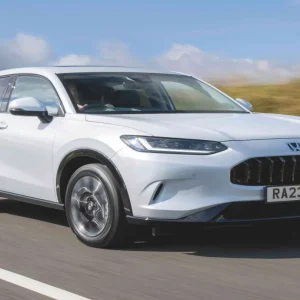
Although you’ll see plenty of ID.3s on the road, VW’s small electric offering has had somewhat of a tumultuous start to life since its launch in 2020. While some lauded its all-electric capabilities, many customers had qualms with its interior quality, infotainment set-up and electric range.
To help keep customers happy, Volkswagen regrouped and gave the ID.3 a facelift ahead of its official second-generation model – which is likely to launch sometime in 2024. But is this updated, pre-second-gen model worth a look? Arguably the biggest change in the facelifted ID.3 is the upgraded infotainment system. This system isn’t going to blow you away in terms of functionality or flair, but it works as it should, it’s responsive and it’s easy to navigate – which cannot be said for the previous system.
The ID.3 still has its faffy, haptic feedback buttons on the steering wheel however, and the different pulses and clicks from these can be difficult to place. Thankfully, the detailed instrument cluster behind the steering wheel – which remains in perfect view at all times due to being fixed to the steering column – helps save the ID.3 from feeling impractical on the road.
Volkswagen’s trademark interior quality was somewhat lacking from the 2020 launch model, but the newly facelifted one has notably more panache. While it doesn’t feel plush or overly German, a greater amount of soft-touch materials in choice hot spots in the cabin help it feel more in line with its VW heritage. Equipment is generally impressive across the range too – although hardly luxurious – with every ID.3 model getting the likes of sat nav, DAB radio, heated seats, wireless phone charging and adaptive cruise control.
The cabin is fairly practical too, thanks in part to its spacious centre console, which has an ingenious smartphone storage/wireless charging slot. The driver’s seat comes equipped with an adjustable arm rest too, which enhances the driving position massively.
Space in the back of the ID.3 is fairly impressive, and only taller passengers will notice some of its drawbacks. For example, kneeroom is superb for those of average height, but six-footers might find their knees sitting quite high due to the steeply-angled seat bases. Head room should be fine for even the lankiest of teenagers though.
What is strange however is that the Pro S model – which has the biggest battery in the range – only has two rear seats, with the centre seat being replaced by a small storage cubby. Volswagen actively discourages you from sitting in this centre seat.
The boot in the ID.3 isn’t the biggest on paper, but for what it lacks in overall capacity it makes up for in simplicity. Its square, no-nonsense shape makes loading it with shopping a breeze, there’s no load lip and while 385 litres with the seats up and 1,267 litres with the seats down isn’t much to shout about, it will likely be enough storage for most small families. It also has some underfloor storage and a handy ski hatch for loading longer objects.
There are currently two variants of the ID.3 – the 58kWh Pro model and the 77kWh Pro S model – which offer an official range of 226 miles and 347 miles respectively. The Pro S model we drove is capable of a higher max charge rate of 170kWs – compared to 120kWs in the Pro model. Charging times for the Pro S model will range from 12 hours from a 7.2 kW wallbox charger to 30 minutes for an 80% charge using a 170kW rapid charger.
Upon the initial launch of the ID.3, some motorists had accuracy issues with estimated range readouts. We didn’t have any such issues in our tests and actually found the range estimations to be pretty bang on.
In terms of drive, the ID.3 is everything you’d want from both an electric and a VW family car – smooth, quiet and comfortable. It’s not overlay exciting – and has nowhere near the same sense of fun as the Cupra Born, an all-electric car based on the same platform – but for those after an A-to-B family commuter, there’s very little to complain about. The suspension is ever so slightly on the firmer side, but that’s common for an EV, and it doesn’t take away from its serene driving experience.
Volkswagen ID.3 Pro S 77kWh
P11D: £42,955
Residual value: 40%
Depreciation: £25,830
Fuel: £3,878
Service, maintenance and repair: £2,497
Cost per mile: 53.67p
Range: 356 miles
CO2 (BIK %): 0g/km (2%)
BIK 20/40% a month: £14/£28
Luggage capacity: 385 litres
Battery size/power: 77kWh/202hp




